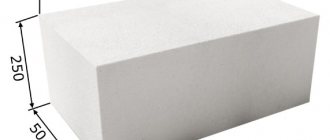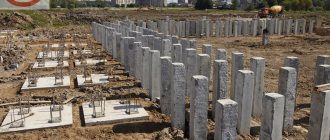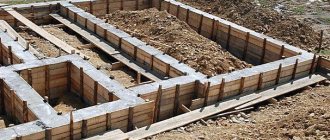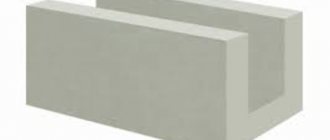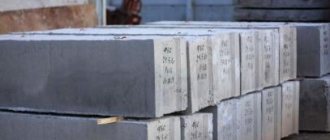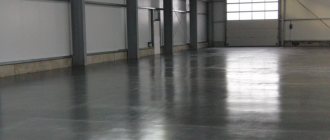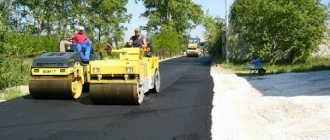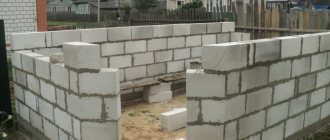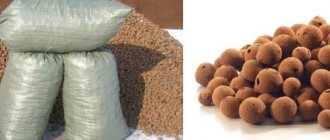Modern industry and the construction industry offers consumers numerous options for fences, fences, picket fences: made of stone, pipes, metal profiles, wood. And in each case it is important to choose the right supports. The service life of the entire structure depends on their quality and strength. One of the most modern options is concrete fence posts. They are purchased ready-made and cast with your own hands.
This article will tell you which option to choose (in-house production or industrial production) and how to carry out the work. We'll look at the advantages and disadvantages of each option.
Concrete pillars: possibilities
Ready-made hollow concrete blocks for supports are sold at construction markets and in stores. The choice of shape, color, size is determined by the imagination and material capabilities of the buyer. The cavity houses the cable for lights and utility lines. For greater strength during installation, the internal part is filled with heavy concrete.
Ready-made structures do not require painting, plastering, or additional decoration. They are produced with imitation of natural stone, wood, marble, and other materials. It is enough to assemble it to the required height, install the top and hang the intermediate sections of the fence. Making concrete pillars with your own hands is a complex, lengthy and labor-intensive process. The result may not be as smooth and overly decorative as ready-made blocks, but it provides more opportunities for further design. The finished surface is painted, plastered, given an “aged” look, covered with artificial “cracks”, mosaics, and lined with sand-lime bricks.
Decorative brick pillars
A dozen explanations can be found for the use of brick in creating fences from various options and its prevalence, but there are only two main ones: the raw material is relatively affordable and can be used with almost any of the generally accepted options. Equally expressively combined and organically intertwined:
- Square brick post and metal rod fence.
- A rounded or patterned support – with elements of hand-hot forging.
- A simple square post that serves as a support for a wooden picket fence, a fence made of boards or corrugated sheets.
- A solid brick pillar - with a fence fabric made of the same material in the form of openwork weaving with holes.
Brick and metal
It is no coincidence that the construction industry has launched the production of imitation brick pillars for brick fences. No rainbow tints can replace the noble texture of stone, wood, or the strict geometric splendor of brick laid by the hand of a master in building solutions.
The same options can be used to imitate the texture of wood or stone, making even simple concrete blocks for fence posts decorative.
The selected fence can be decorated by choosing the appropriate type of brick produced by modern enterprises.
Typesetting blocks
Sand-lime brick
Sand-lime brick is an original, sought-after type of construction product made from mineral fillers, lime and quartz, mixed in proportions prescribed by manufacturing technology.
Its high strength, sound absorption ability (up to 12% of noise coming from the street) and frost resistance in temperate climates are the main arguments in favor of this material.
The disadvantages include only moisture permeability, but this can be ignored when constructing facilities in regions with moderate rainfall. But the color range in which sand-lime bricks can be purchased allows you to give free rein to your imagination.
Rounded pillars
Test pits are prepared at the locations where the supports are located. The depth depends on the height of the fence and the load on the posts. Optimally, the soil is removed up to 1 meter. Sand is poured into the bottom and compacted thoroughly. Next is crushed stone.
An asbestos-cement or metal pipe is cut in half along its entire length. Ears and locks are welded to individual parts for connection. This way the form will be reusable. A pipe is installed in the pit, the space around is filled with a concrete mixture at the rate of 1 part cement x 2 parts fine crushed stone (waste) x 3 parts carefully sifted sand. In a pole mold, pre-lubricated with machine oil or grease, a base of reinforcement and thick wire is placed. Next, concrete is poured to the height of 90% of the pipe. Puncture the poured mixture several times to release air. The formwork is removed after the concrete has set.
Sergey Yurievich
Construction of houses, extensions, terraces and verandas.
Ask a Question
Don’t forget about the “ears” or other embedded parts for attaching the fence sections. Special holes are made in the mold for them. Installation of embedded parts is carried out before pouring the concrete mixture.
Manufacturing and installation of concrete supports
In order to protect the site from the penetration of neighboring animals, as well as uninvited guests, the fence must withstand significant loads. That is why it is important to carefully prepare the base and install the load-bearing elements.
Creating a frame for a future fence can be divided into several blocks:
- site preparation;
- construction of a foundation under each pillar;
- installation of supports and guides between them.
After making the frame, the main fence fabric made of wood, metal or any other selected material is installed.
Supports of other forms
Rectangular and square pillars can be cast in advance in molds using the same method as for round pillars. The formwork is placed in the pit, poured and dried.
If the pillars are prepared in advance, on a vibrating table, make sure that the surface does not dry out and moisten it periodically. Installation of finished products is carried out after complete setting and strength gain - no earlier than 2-3 weeks.
Regardless of the shape of the supports, it is important to ensure that there are no deviations from the vertical. Otherwise, the fence will look sloppy and unattractive from an aesthetic point of view. It is impossible to correct the distortions.
Design and features of supports
Concrete supports, which serve as the main load-bearing element for the fence, also perform a decorative function, so their appearance is no less important than strength and durability.
Such elements can be made in various forms:
- round;
- square;
- rectangular;
- with a trapezoidal base.
Due to the possibility of using different types of formwork during production, the texture of the product can also differ significantly. Particularly popular are decorative concrete posts used as external fence supports.
Of course, it is possible to change the surface of the product using special formwork, but this method of production leads to an increase in the cost of supports. The best option is to combine special decorative blocks with subsequent monolithization of the entire structure.
Painting
The following types of paints are used for concrete:
- acrylic. Dry within 24 hours. For application you will need a roller or spray gun. The coating is resistant to water and sunlight;
- epoxy. Less durable than acrylic based ones. Before starting work, the components are mixed in the proportion specified by the manufacturer. The paint is resistant to water, acid and alkali solutions;
- rubber. Do not crack or deform in adverse weather conditions. Disadvantage - deep color will be obtained after 2-3 layers of dye. Advantage: applied to a damp surface;
- polyurethane. Resistant to external influences, including mechanical ones. Depending on the composition, they dry within 2-14 days.
Characteristics
Decorative fences made of concrete are often called Euro fences. Their design is both a fence and a decoration for country houses. The increased demand for them is due to a number of factors, including:
- structural strength, which allows you to avoid mechanical damage with virtually no maintenance work;
- the surface of the product is not subject to destruction due to the influence of natural factors in the form of precipitation, seasonal temperature changes, direct exposure to sunlight;
- high durability of products that are designed for at least 30 years;
- compactness, simplicity and ease of installation, allowing to minimize the amount of work during installation and labor costs;
- aesthetically original appearance. The decorative decoration of Euro fences is replete with a variety of shapes and designs. The reinforced base and concrete pouring turned out to be a flexible tool, thanks to which you can implement many design solutions and original options for building a beautiful fence for any home, even the most sophisticated from an architectural point of view.
Plastering
The gray surface of concrete is not very attractive. Plaster will help you decorate the fence in the same style as the house:
- on a gypsum basis. Does not contain chemicals or reagents. Mold and mildew will never appear on it. Resistant to mechanical shocks;
- with mosaic effect. Stone chips are added to the cement or gypsum base. The finished surface is washed and painted. There are no traces left from water, sun, mechanical shocks;
- based on cement or limestone. Features maximum strength.;
- acrylic, silicone, mineral. The introduction of plasticizers, modifiers, and polyurethane granules into cement allows you to create surfaces with any effect: from natural wood to stone chips.
Types of pillars
- Wooden fence posts are suitable for those who decide to build a temporary fence. The price for them is quite affordable, and the installation method is clear to everyone. The most important thing to pay attention to is the mandatory treatment of the material with antiseptics. Otherwise, the service life of the wooden fence will be significantly reduced.
- Metal poles are considered the most durable and durable, however, they are much more expensive than wooden blocks and cement-sand mixture. They have another advantage - the possibility of reuse after dismantling.
The figure shows how metal poles are installed correctly
- Brick pillars have the best decorative qualities, but are several times more expensive and more difficult to install. Especially for those who have never encountered brickwork.
We will talk about the benefits of a concrete fence post in more detail, so that you can understand why this particular method is most relevant for fencing.
Characteristics of concrete pillars
Before starting the work process, let's look at all the positive and negative aspects that concrete fence posts have:
- The advantage of this design is strength and durability . If we compare, for example, with wooden products, the service life of concrete is several tens of times longer.
Note! It all depends on the quality of the cement, so we recommend purchasing the M400 or M500 brand.
- Concrete pillars can be finished with any material : paint, plaster, plastic panels or decorative stone. The main thing is to properly prepare the surface; for example, for plastering, be sure to use a reinforcing mesh for the fence, which allows you to strengthen the bulk mixture.
- Simple installation , which does not require special tools, expensive materials or the help of specialists; everything can be done with your own hands. You will see this for yourself by reading our article to the end.
Now let's look at the disadvantages of concrete pillars:
- They require a carefully prepared foundation for the fence. Without it, the structure may shrink, become deformed, and even collapse over time.
- The reliability and durability of the structure depends entirely on the quality of the ingredients used. Particular attention should be paid to sand, cement and plasticizers that must be added to the solution.
- The first step is to dig a hole about one and a half meters deep. It can be a little less, it all depends on the thickness of the pillar.
Clinker, sand-lime brick
Laying is done after the concrete base has completely dried. Otherwise, moisture will remain inside and have a destructive effect on the structure.
The work uses a sand-cement mixture or special construction adhesives. Brick laying begins from the bottom with the obligatory overlapping of layers. Upon completion, staining is carried out in accordance with the manufacturer's recommendations.
The fence is the face of your home and site. Take its construction very seriously. It should not collapse at the first breeze or lose its visual appeal in a year.
Making wooden supports
In order to make fence posts from wooden material , you can use the following algorithm of actions:
- The first thing you need to do is decide on a suitable material; the durability and reliability of the future structure depends on this. The best option for this would be oak.
- Next, the selected tree trunk is cleared of bark and processing begins.
- The next stage is sanding the barrel. After the process is completed, it is necessary to apply tar , resin or a specialized product to the lower part, which will prevent the wood from rotting.
- After applying the coating, the columns are provided with waterproofing. Ruberoid or dense polyethylene is suitable for this. The barrel is wrapped in one of the selected materials.
Important: it is better not to install the wooden type of poles directly into the ground. It is recommended to make the base from concrete.
Having completed all the points from the specified algorithm, you can begin installing the pillars . A description of the installation process can be found below.

